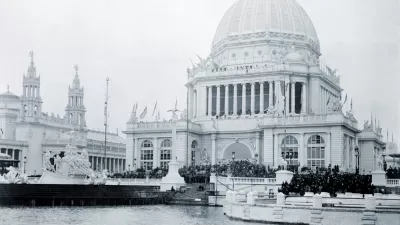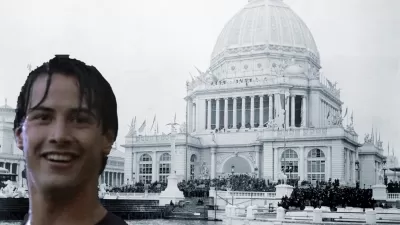This year is the centennial of Daniel Burnham's Plan of Chicago, a landmark in the world of urban planning. Martha Frish has had the pleasure of looking through Burnham's handwritten documents and shares some of his wisdom that didn't make it into the final plan.
 Daniel H. Burnham and Edward H. Bennett published The Plan of Chicago on July 4th, 1909, under the auspices of The Commercial Club of Chicago. In 2004, the Plan of Chicago Centennial Committee was established to begin to think about how best to commemorate the publication of this seminal document. To build upon several years of planning by the Committee, The Burnham Plan Centennial Committee was convened by a group of business and civic leaders in late 2006.
Daniel H. Burnham and Edward H. Bennett published The Plan of Chicago on July 4th, 1909, under the auspices of The Commercial Club of Chicago. In 2004, the Plan of Chicago Centennial Committee was established to begin to think about how best to commemorate the publication of this seminal document. To build upon several years of planning by the Committee, The Burnham Plan Centennial Committee was convened by a group of business and civic leaders in late 2006.
The Burnham Plan Centennial Program Partners eventually included 223 organizations, institutions and entities throughout the Chicago metropolitan region who have been engaged in opportunities to inspire the region's leaders, communities and institutions to build on the Burnham Plan and act boldly to shape the future of the Chicago region during 2009. During the October 2008 – October 2009 year, the Committee has coordinated hundreds of programs and learning resources consistent with its "Bold Plans. Big Dreams" theme.
Much of the year's discussion about the plan has focused on Burnham's ideas for improving Chicago's physical attributes and infrastructure – what Carol Coletta, President of CEO's for Cities, has called "the big, muscular thing," the theoretical and practical reasons for building transportation systems, parks, boulevards, parkways and cultural and civic institutions, as opposed to addressing something modest such as 'happiness.'

Burnham's handwritten drafts for the plan are housed in the Ryerson and Burnham Libraries at the Art Institute of Chicago, and research into the texts of the four unpublished drafts of the Plan has continued. A remarkable number of passages in the drafts of the plan contain Burnham's passionate commentary on potential mechanisms for the promotion of a sense of citizenship. These comments tend not to emphasize infrastructure, but they have a strong philosophical component - and they were omitted from the published version.
Some examples:
- "The failure of municipal government in the United States thus far has been due primarily to the fact that at the present time the city is regarded merely as an aggregation of individuals each seeking first his own support and after that the furtherance of his own ambitions. Growth has been so rapid, opportunities have come and gone so quickly, changes have been so rapid that there has been no time to pause and consider what breakers were ahead. It is only within comparatively recent times that people have begun to realize the imperative need of organizing the forces that make for honesty and decency, for better physical conditions, for broader charities, and for the prevention as well as the cure of evils."
- "...there is no stronger appeal made to the American citizen of to-day than comes from the call of one's native or adopted city to enter upon the service of creating better surroundings not only for one's self, but for all those who must of necessity earn their bread in the sweat of their brows."
- "We now regard the promotion of good, robust health of body and mind, as necessary public duties, in order that the individual may be benefitted and that the community at large may have a higher average degree of good citizenship, and good citizenship is what the makers of this design for the development of the city are after."
- "Another important thing in school life is the playground. Indeed, so much of the training of a child toward good citizen-ship occurs here the state would be almost warranted in giving it first importance "
- "The State ought to see that every child while under its care, in the public schools, shall have the advantage of sunlight. It is not only the direct effect of sun shine on the animal, but its effect on the air of the room even out of school hours that should be considered. Every school room should face south, and could this be brought about there is little doubt that some percentage of added bodily strength and of moral tone would be apparent in the community "
- "It may be broadly said that the experience of the last few years has shown that children brought up in sun-lit rooms have some percentage of better health and better moral tone, everything else being equal, than those who have lived the majority of their school lives. This fact should be recognized and acted upon."
- "Habitual cheerfulness is of enormous value in the community and it should be cultivated."
- "Does it not therefore behoove the state to create conditions conducive to strengthen body and mind?"
Burnham himself began Chapter 1 of one of the drafts by writing, "Chicago repeats the history of all great cities in that its location was due to convenience, and its growth has been the result of commerce." This may be universally true, but it is now time that his comments about promoting cheerfulness, conditions conducive to strengthening body and mind, and citizenship – qualities that might today come under the heading of "quality of life" – should receive equal attention in modern society. They may seem amorphous, or mere common sense - but American urban history has demonstrated that "the training of a child toward good citizen-ship" in the playground has not yet been given the scholarly and professional attention these comments deserve.
As a start, there is a significant pedagogical opportunity in including the Plan in various college and graduate school curricula, and connecting it to the physical and sociological attributes of Chicago – and other cities - then and now. The Plan of Chicago and its drafts may be used as a basis for student papers on specific aspects of history and geography; architectural and urban history; urban planning and public policy. Teaching students to think comprehensively and ambitiously about how they can "create better surroundings" is a prime example of connecting coursework to students' real lives, and is, after all, the underlying assumption behind the field of urban planning.
Martha Frish, AICP is an instructor at The School Of The Art Institute Of Chicago, and currently a a lecturer at DePaul University in conjunction with The Burnham Plan Centennial.

Alabama: Trump Terminates Settlements for Black Communities Harmed By Raw Sewage
Trump deemed the landmark civil rights agreement “illegal DEI and environmental justice policy.”

Planetizen Federal Action Tracker
A weekly monitor of how Trump’s orders and actions are impacting planners and planning in America.

The 120 Year Old Tiny Home Villages That Sheltered San Francisco’s Earthquake Refugees
More than a century ago, San Francisco mobilized to house thousands of residents displaced by the 1906 earthquake. Could their strategy offer a model for the present?

Opinion: California’s SB 79 Would Improve Housing Affordability and Transit Access
A proposed bill would legalize transit-oriented development statewide.

Record Temperatures Prompt Push for Environmental Justice Bills
Nevada legislators are proposing laws that would mandate heat mitigation measures to protect residents from the impacts of extreme heat.

Downtown Pittsburgh Set to Gain 1,300 New Housing Units
Pittsburgh’s office buildings, many of which date back to the early 20th century, are prime candidates for conversion to housing.
Urban Design for Planners 1: Software Tools
This six-course series explores essential urban design concepts using open source software and equips planners with the tools they need to participate fully in the urban design process.
Planning for Universal Design
Learn the tools for implementing Universal Design in planning regulations.
Clanton & Associates, Inc.
Jessamine County Fiscal Court
Institute for Housing and Urban Development Studies (IHS)
City of Grandview
Harvard GSD Executive Education
Toledo-Lucas County Plan Commissions
Salt Lake City
NYU Wagner Graduate School of Public Service




























